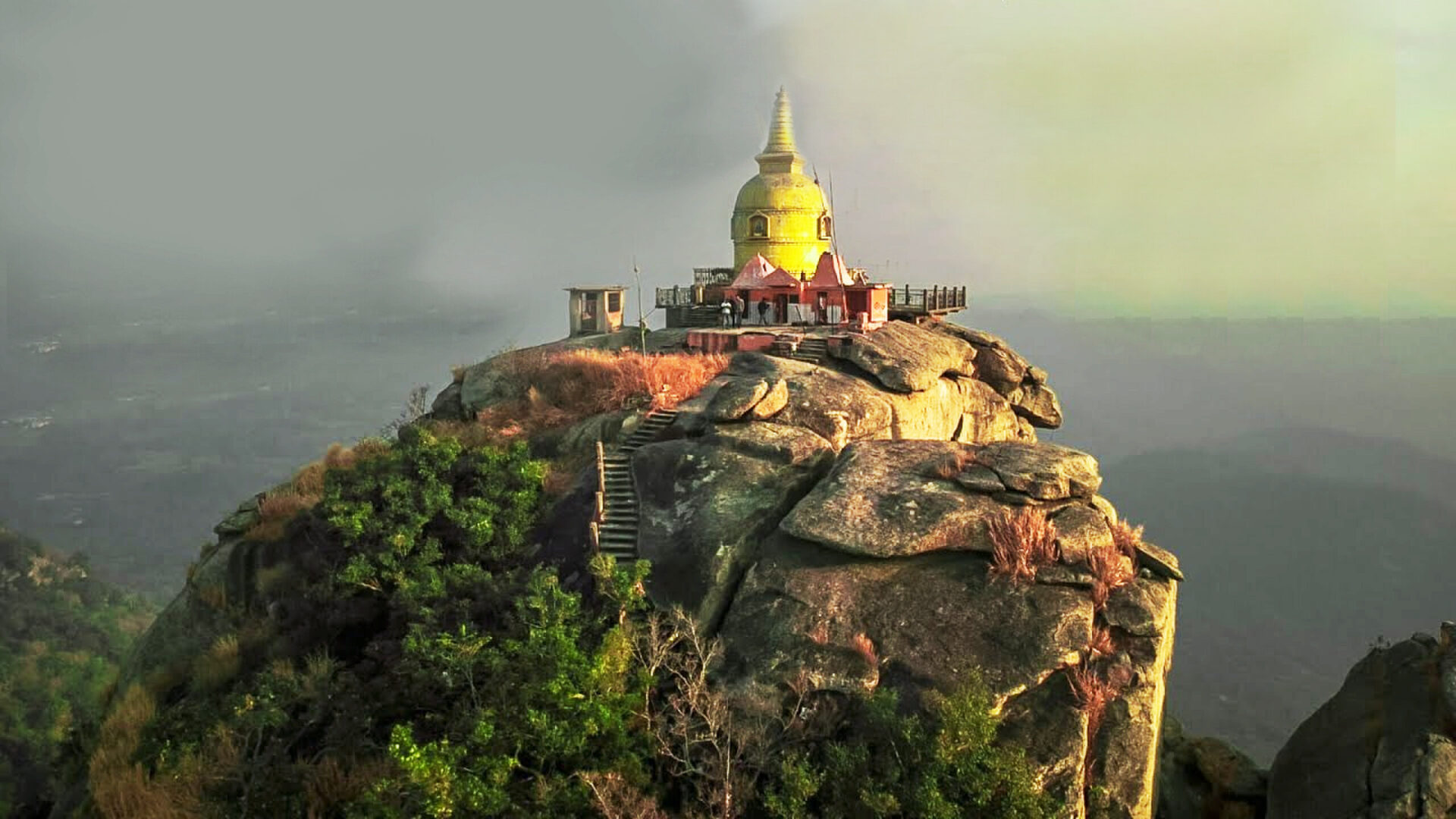Gurpa Hill: A Sacred Haven on Bihar’s Spiritual Landscape

Introduction
Gurpa Hill, also known as Gurupada Giri or Kukkutpada Giri, stands as a significant natural and historical landmark nestled in the Gaya district of Bihar, India. Located approximately 50 kilometers from Gaya on the Bihar-Jharkhand border, this hill holds profound importance in both Buddhist pilgrimage and historical narratives. It is revered for its association with Maha Kassapa, one of Lord Buddha’s foremost disciples, who is believed to have achieved nirvana at Gurpa Hill. This tranquil site not only offers spiritual solace but also echoes with the profound teachings of Buddhism, making it a destination of deep reverence for pilgrims and visitors alike. The region of Bihar itself carries immense historical weight as the birthplace of several ancient Indian kingdoms and a cradle of spiritual awakening, notably linked with the teachings of Lord Buddha. Gurpa Hill, amidst its serene surroundings and historical depth, continues to attract pilgrims and tourists seeking to connect with its rich spiritual heritage and tranquil ambiance.
Historical and Religious Significance
Gurpa Hill, located in Gaya, holds profound historical and religious significance for both Buddhists and Hindus. Its primary importance lies in its association with Maha Kassapa, a revered figure in early Buddhism known for his wisdom and pivotal role in the community of disciples following Lord Buddha. Following the parinirvana (final nirvana) of Lord Buddha, Maha Kassapa chose Gurpa Hill as his final abode. According to Buddhist tradition, he retreated into a cave on the hill and entered deep meditation, ultimately attaining nirvana. This event sanctified Gurpa Hill as a sacred site for Buddhists, symbolizing the attainment of spiritual liberation and serving as a place of pilgrimage where followers reflect on Maha Kassapa’s teachings and seek spiritual enlightenment. In addition to its Buddhist significance, Gurpa Hill is also esteemed by Hindus. The Gurupada Temple, located on the hill, is believed to enshrine the footprints of Lord Vishnu. For Hindu devotees, this temple is a site of veneration and pilgrimage, where they pay homage to Lord Vishnu and seek divine blessings. Gurpa Hill thus stands as a testament to the interwoven religious fabric of Buddhism and Hinduism, embodying spiritual harmony and reverence. Its serene environment continues to attract visitors from both faiths, who come to contemplate, meditate, and experience the profound spiritual energy that permeates this sacred site.
Geographical and Natural Beauty
Gurpa Hill is one of the tallest peaks in the Gangetic plains, offering breathtaking views of the surrounding countryside. Located approximately 30 kilometers from the city of Gaya, the hill is part of the scenic landscape that includes several other significant Buddhist sites, such as the Mahabodhi Temple in Bodh Gaya, about 96 kilometers from Patna, the capital of Bihar. The natural beauty of the area includes lush forests, waterfalls, and stunning sunrise and sunset views. These features make Gurpa Hill an ideal destination for nature lovers and those seeking a tranquil environment for meditation and reflection.
Attractions and Pilgrimage Sites
- Maha Kassapa’s Cave: This cave is revered as the spot where Maha Kassapa attained nirvana. Pilgrims visit this cave to meditate and pay their respects.
- Gurupada Temple: Located on Gurpa Hill, this temple is believed to house the footprints of Lord Vishnu. It is a significant site for both Buddhist and Hindu pilgrims.
- Stupa and Buddhist Temple: At the summit, there is a stupa and a Buddhist temple, important for religious activities.
- Rough Steep Path: The path leading to the summit is steep and rugged, adding a sense of adventure for visitors and pilgrims trekking to the top.
- Panoramic Views: The summit offers breathtaking views of the surrounding landscapes, providing a serene environment ideal for meditation and reflection.
- Historical Visits: The site has been visited by many prominent Buddhist pilgrims, including the Chinese monk Xuanzang, who documented his travels to India in the 7th century.
How to Visit Gurpa Hill
- By Air
The nearest airport is in Patna, about 96 kilometers away. From Patna, travelers can hire a taxi or take a bus to Gaya and then proceed to Gurpa Hill.
- By Train
The closest railway station is Gaya Junction, which is well-connected to major cities across India. From Gaya Junction, visitors can take a taxi or local bus to reach Gurpa Hill.
- By Road
Gurpa Hill is accessible by road from Gaya. Visitors can hire taxis or take local buses from Gaya to reach the hill. The journey from Gaya to Gurpa Hill is approximately 50 kilometers and offers scenic views of the rural landscape.
Nearby Attractions
- Mahabodhi Temple: Located in Bodh Gaya, this UNESCO World Heritage Site marks the location where Buddha attained enlightenment and is a major pilgrimage destination for Buddhists worldwide.
- Vishnupad Temple: Situated in Gaya, this temple is dedicated to Lord Vishnu and is another important religious site in the region.
Conclusion
Gurpa Hill stands as a timeless testament to Bihar’s rich spiritual heritage and natural splendor. Its association with Maha Kassapa’s attainment of nirvana and the veneration of Lord Vishnu at Gurupada Temple make it a revered pilgrimage site for both Buddhists and Hindus alike. The panoramic views, lush surroundings, and tranquil atmosphere offer visitors a sanctuary for reflection, meditation, and spiritual rejuvenation.
Whether you’re drawn by the historical significance, the natural beauty, or seeking a moment of peace, Gurpa Hill promises an enriching experience. Embrace the serenity, delve into the depths of spiritual history, and leave with a renewed sense of awe and reverence.
Plan your journey to Gurpa Hill today and embark on a voyage that transcends time and space, connecting you to the profound essence of Bihar’s cultural tapestry.
Top 13 Facts about Gurpa Hill
- Gurpa Hill is in the Gaya district of Bihar, India.
- It is associated with Maha Kassapa, a chief disciple of Lord Buddha.
- Maha Kassapa attained nirvana on Gurpa Hill.
- It is one of the tallest peaks in the Gangetic plains.
- At the summit, there is a stupa and a Buddhist temple.
- Many Buddhist pilgrims, including Xuanzang, have visited the site.
- Gurpa Hill is about 30 kilometers from Gaya.
- The closest airport is in Patna, about 96 kilometers away.
- The nearest railway station is Gaya Junction.
- The summit offers panoramic views of the surrounding landscape.
- There is a rough, steep path leading to the top.
- Mahabodhi Temple in Bodh Gaya is a significant nearby site.
- The hill provides a serene environment ideal for meditation and reflection.
FAQs
Gurpa Hill, also known as Gurupada Giri or Kukkutpada Giri, is a significant natural and historical landmark located in the Gaya district of Bihar, India. It holds profound importance in both Buddhist pilgrimage and historical narratives.
Gurpa Hill is significant for its association with Maha Kassapa, one of Lord Buddha’s foremost disciples, who is believed to have attained nirvana at this site. It is revered by Buddhists and Hindus alike for its spiritual and religious significance.
Gurpa Hill is accessible by road from Gaya, which is approximately 50 kilometers away. The nearest airport is in Patna, about 96 kilometers from Gurpa Hill, and the closest railway station is Gaya Junction. From Gaya or Patna, visitors can hire taxis or take local buses to reach Gurpa Hill.
At Gurpa Hill, visitors can explore Maha Kassapa’s Cave, believed to be the place where he attained nirvana, and the Gurupada Temple, which houses the footprints of Lord Vishnu. The summit also features a stupa and a Buddhist temple, offering panoramic views of the surrounding landscapes.
Yes, Gurpa Hill is open to visitors of all faiths and backgrounds. It welcomes pilgrims seeking spiritual solace, historians exploring its cultural significance, and nature enthusiasts admiring its natural beauty.
The best time to visit Gurpa Hill is during the cooler months, from October to March, when the weather is pleasant for trekking and outdoor activities. Avoid the monsoon season (July to September) due to heavy rainfall that may make the paths slippery and challenging.
While Gurpa Hill itself may not have accommodations, visitors can find lodging options in nearby Gaya or Bodh Gaya, which offer a range of hotels, guesthouses, and lodges to suit various budgets and preferences.
It is advisable to wear comfortable clothing and sturdy shoes suitable for walking on uneven terrain, especially if planning to trek to the summit. Light layers are recommended, as the weather can vary throughout the day.
Visitors are encouraged to respect the sanctity of the site by observing silence in certain areas, removing footwear before entering temples or caves, and refraining from photography in sensitive religious spaces unless permitted.
While it is possible to explore Gurpa Hill independently, hiring a local guide can enhance the experience by providing historical insights, navigating the terrain safely, and ensuring you visit key sites of significance.



